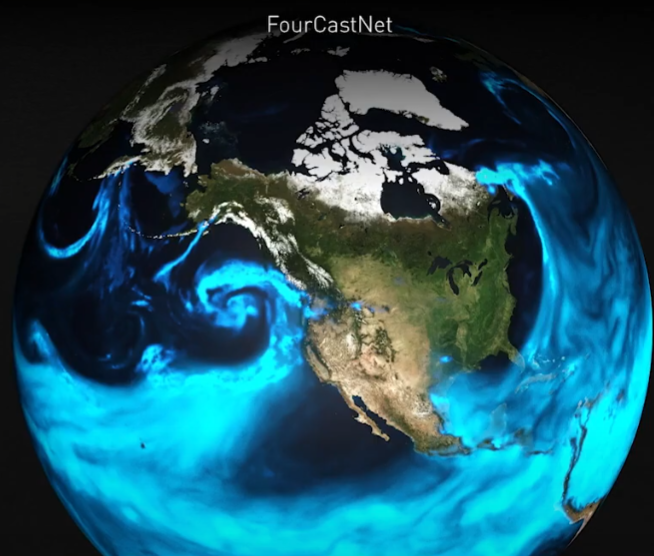Nvidia Powers Scientific Digital Twins with Modulus, Omniverse

An accurate digital twin can be a boon to scientific endeavors, from recreating individual buildings in a city to understand energy use to recreating the Earth’s climate system to understand the effects of policies on climate change. At GTC21, Nvidia made waves by announcing that its Modulus framework for physics-based ML models and its Omniverse real-time simulation platform were being used to power digital twins of power plants for predictive maintenance — and that it was planning to use these tools to create a digital twin of the planet in the coming years. At GTC22, Nvidia is doubling down on its scientific twins, announcing further integration of Omniverse and Modulus for Earth-2 and renewable energy simulations.
“Basically, we’re integrating Modulus within Omniverse,” explained Dion Harris, senior manager for datacenter products at Nvidia. He explained that Modulus would be available as an extension in Omniverse, allowing users to build AI surrogate models that provide real-time, interactive, AI-driven simulation.
Nearing Earth-2
Earth-2 was, again, the headline item of this segment. Harris showed a chart illustrating projected progress toward sub-meter resolution in Earth system modeling — the required resolution for resolving many important cloud formations. “It’ll be another 40 years before we get there,” Harris said. “So that’s simply too long, so the whole promise of Earth-2 is to basically bring about AI, bring about digital twin modeling so that we can speed up that process and get a better understanding of climate and therefore, hopefully, do something about it before it’s too late.”
Earth-2, he said, was different: an unprecedented combination of first-principles simulation and data-driven models, presented in a real-time, interactive digital twin.
“As a first step, we’ve developed an AI surrogate model,” he said. “So we’ve worked with collaborators from Berkeley Lab, CalTech, Purdue, Michigan and Rice University, and we’ve built this AI surrogate model called FourCastNet.”
FourCastNet — short for “Fourier Forecasting Neural Network” — is a Transformer-based model that allows models to be trained at a low resolution, then interpolate the results for application with higher-resolution data. FourCastNet, Harris said, was up to 45,000× faster than traditional computational fluid dynamics at comparable accuracy (and with a 12,000 percent increase in energy efficiency). Nvidia says that this performance improvement enables larger ensemble climate models with thousands of iterations.
The Fourier neural operator that enables these advances is now integrated into Nvidia’s digital twin tools, enabling users to build models like FourCastNet within Modulus for use in Omniverse.
“Digital twins allow researchers and decision-makers to interact with data and rapidly explore what-if scenarios, which are nearly impossible with traditional modeling techniques because they are expensive and time-consuming,” said Karthik Kashinath, senior developer technology scientist and engineer at Nvidia. “Central to Earth-2, Nvidia's FourCastNet enables the development of Earth’s digital twin by emulating the physics and dynamics of global weather faster and more accurately.”
"For the first time, a deep learning model has achieved better accuracy and skill on precipitation forecasting than state-of-the-art numerical models," added Nvidia CEO Jensen Huang during his keynote today.
Twinned wind
The second use case for the Modulus-Omniverse combo that Nvidia showed off was a collaboration with Siemens, which previously worked with Nvidia’s digital twins for predictive power plant maintenance. This time, they worked with Siemens Gamesa, a renewable energy company owned by Siemens Energy. “What they’ve been able to do is take Omniverse and Modulus and build a digital twin of wind farms,” Harris said.
“If you look at a wind farm, it looks like it’s randomly distributed,” he continued. “But in actuality they’re always carefully placed so that the wakes and the streams coming off of the subsequent wind farms help power and propel to create more power as you go through that chain of windmills.” Figuring out how to optimize this placement, explained, requires “intense simulation” — so Siemens Gamesa is using Modulus and Omniverse to create digital twins of its wind farms to simulate the effects of turbines in close proximity to one another. Nvidia says that the use of its digital twins for this application — also powered by that Fourier neural operator — allows for an up to 4,000× speedup compared to traditional large-eddy simulation models.
“The collaboration between Siemens Gamesa and Nvidia has meant a great step forward in accelerating both the computational speed and the deployment speed of our latest algorithms development in such a complex field as computational fluid dynamics, and set the foundations for a strong partnership in the future,” said Sergio Dominguez, onshore digital portfolio manager at Siemens Gamesa.
So, while Earth-2 isn’t quite here yet, Nvidia is still touting real results from its digital twins platform for scientific applications.
“Accelerated computing with AI at datacenter scale has the potential to deliver millionfold increases in performance to tackle challenges, such as mitigating climate change, discovering drugs and finding new sources of renewable energy,” said Ian Buck, vice president, Accelerated Computing at Nvidia. “Nvidia's AI-enabled framework for scientific digital twins equips researchers to pursue solutions to these massive problems.”











